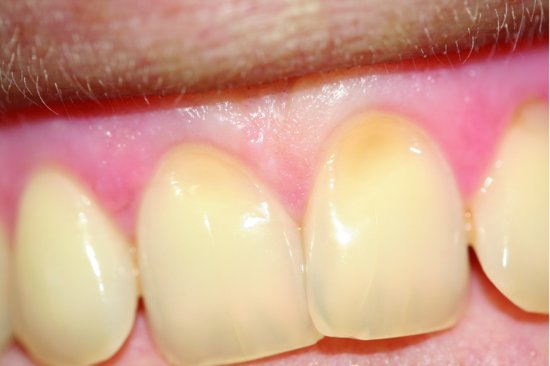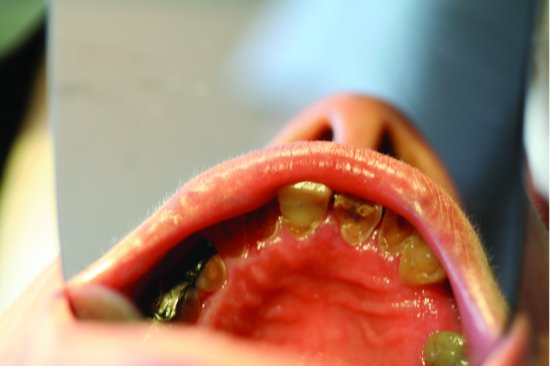Chapter 6
Tooth surface loss and sensitivity
WHAT IS TOOTH SURFACE LOSS?
Tooth surface loss (TSL) describes the loss of dental hard tissue when bacterial action (e.g. in caries) is not a factor. The 2003 Children’s Dental Health Survey [1] showed that over half of the 5 year olds surveyed showed some signs of TSL. The 2009 Adult Dental Health Survey [2] showed that the prevalence of TSL in England had increased since the previous survey 10 years before, particularly in moderate TSL where values had risen from 11% in 1998 to 15% in 2009.
There are four main types of TSL:
- Erosion.
- Attrition.
- Abrasion.
- Abfraction.
Erosion
Erosion (Figure 6.1) is usually seen on occlusal, palatal and lingual surfaces of anterior teeth and sometimes on cervical margins. Dental professionals are seeing much more erosion in recent years and there are a number of reasons for this, mainly associated with modern lifestyle.
Figure 6.1 (a) Erosion on labial surface of upper incisors (© Carole Hollins. Reproduced with permission). (b) Erosion on palatal surface of upper incisors (From Hollins, C. (2008) [3]. Reproduced with permission of John Wiley & Sons, Ltd)
(a) 
(b) 
Aetiology
Erosion is almost always associated with high acidity, which can be caused by intrinsic (natural) and extrinsic (outside) factors, including:
- Diet. Often through frequent sipping of carbonated drinks or regular consumption of:
- Citrus fruits/drinks. The recommended ‘5-a-day’ fruit and vegetable intake in the United Kingdom, whilst commendable for general health reasons, can encourage people to eat acid-rich fruits between meals and contribute to erosion.
- Cider, alcopops, white wine (especially among wine tasters and heavy wine drinkers).
- Fruit teas.
- Some sports drinks.
- Pickles.
- Regurgitation of stomach acids. Commonly seen in anorexics and bulimics, pregnant patients or in people with chronic gastric disorders. Hydrochloric acid is responsible in these cases.
- Oral medications (those with low pH).
- Acid pollution in the workplace. Now rare in the United Kingdom due to improved Health and Safety laws, but often occurred in factories (galvanising, pickling, engraving and battery production) – due to an acidic atmosphere.
Features
Features of erosion include:
- Affected surfaces have a smooth, polished appearance.
- Where an amalgam filling is present, the tooth surface can reduce around it leaving a raised filling.
- Anatomical shape is lost or shallow depressions may appear.
Patients commonly affected by erosion
Patients commonly affected by erosion include:
- Teenagers who sip carbonated drinks.
- Sports players with whom isotonic sports drinks have become popular.
- Patients with hiatus hernia/similar disorders which cause acid regurgitation.
- Anorexics, bulimics and pregnant women who vomit regularly.
- People who regularly eat citrus fruits (e.g. grapefruit for breakfast, followed by vigorous and damaging brushing) or drink high volumes of citrus juices.
- Chronic alcoholics where regurgitation may occur.
- Elderly or medically compromised patients whose saliva is greatly reduced.
- Preschool children with poor diets and oral hygiene.
Management/treatment
Management of erosion involves:
- Modifying diet (if diet-related). Particularly restricting acidic foods and drinks (and to regular mealtimes).
- Gentle toothbrushing – allow an hour after consuming acidic foods or drinks. Do not brush immediately after vomiting.
- Fluoride application – to increase tooth resistance to acid (for example, Colgate Duraphat® 2800 or 5000).
- Application of GC Recaldent™ Tooth Mousse.
- Desensitising agents and toothpastes.
- Managing/treating underlying disorders.
- Reconstructing affected teeth.
If the affected teeth show signs of staining then erosion is no longer happening as stains would be washed away by the acids.
Attritio/>
Stay updated, free dental videos. Join our Telegram channel

VIDEdental - Online dental courses


